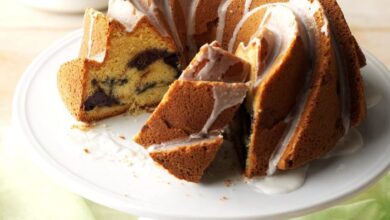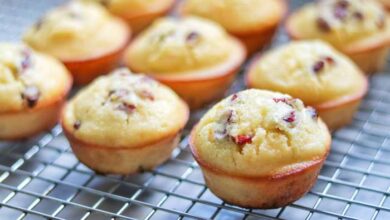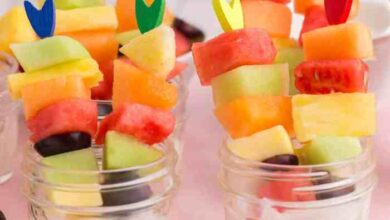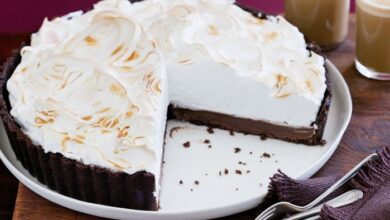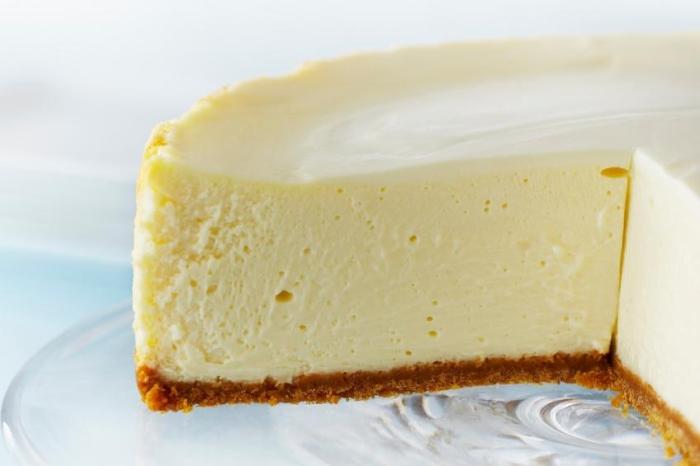
Classic New York Style Cheesecake: A Culinary Icon
Classic New York style cheesecake, a culinary icon, has captured hearts and taste buds for generations. Its rich history, deeply rooted in the city’s vibrant culture, is as captivating as its creamy, decadent texture. From humble beginnings to its present-day status as a quintessential dessert, this cheesecake embodies the spirit of New York City itself: bold, iconic, and undeniably delicious.
The allure of New York-style cheesecake lies in its simplicity and perfection. The signature dense, creamy filling, achieved through a specific blend of cream cheese, sugar, and eggs, melts in your mouth, while the buttery, slightly sweet crust provides the perfect complement.
Whether you’re a seasoned baker or a culinary novice, the process of creating this iconic dessert is both rewarding and surprisingly approachable.
The Perfect Crust
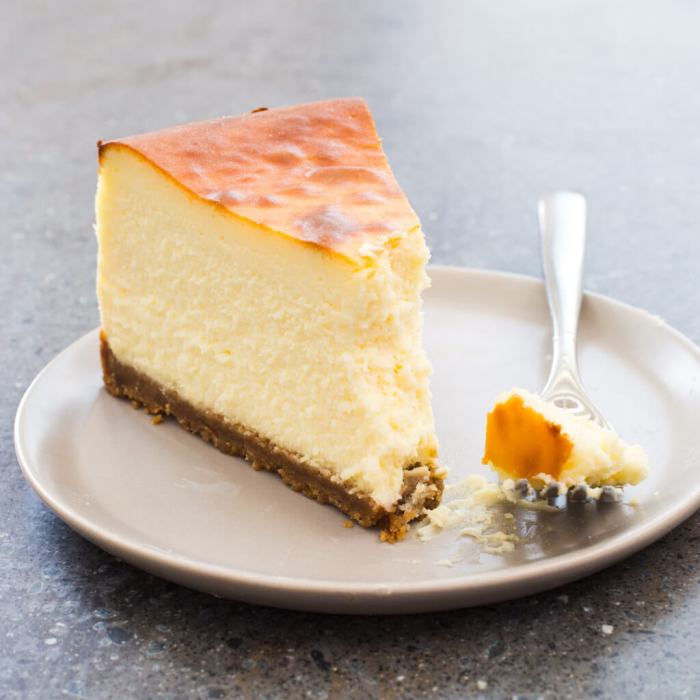
The crust is the foundation of a New York-style cheesecake, providing a delightful contrast to the creamy filling. A well-baked crust should be crisp, flavorful, and hold its shape. It should also complement the cheesecake’s richness, not overpower it.
Crust Types
The most common crust for New York-style cheesecake is a graham cracker crust. This classic choice offers a simple, familiar flavor that pairs well with the cheesecake filling. However, other crust variations can add a unique dimension to your cheesecake experience.
Here are some popular crust types:
- Graham Cracker Crust:This classic crust is made with finely crushed graham crackers, butter, and sugar. It offers a simple, familiar flavor that complements the cheesecake filling.
- Chocolate Crust:This variation adds a rich, decadent touch to the cheesecake. It’s made with chocolate wafers or cookies, butter, and sugar.
- Oatmeal Crust:This crust provides a slightly nutty and chewy texture. It’s made with rolled oats, butter, and sugar.
- Cookie Crust:You can use your favorite cookies to create a unique crust. Experiment with different types of cookies, like chocolate chip, shortbread, or even biscotti.
- Nut Crust:This crust adds a crunchy texture and nutty flavor. You can use almonds, pecans, walnuts, or a mixture of nuts.
Baking the Crust
The key to a perfect crust is baking it until it’s golden brown and crisp. This ensures that the crust holds its shape and provides a delightful crunch when you bite into the cheesecake.Here are some tips for baking the perfect crust:
- Preheat the oven to 350°F (175°C): This ensures that the crust bakes evenly and doesn’t become soggy.
- Blind bake the crust: This involves baking the crust without the filling for about 10-15 minutes. This helps to prevent the crust from becoming soggy and ensures that it’s fully cooked before the cheesecake filling is added.
- Use a pie weight or dried beans: This helps to prevent the crust from bubbling up while it’s baking.
- Let the crust cool completely: This allows the crust to set and prevents it from becoming soggy when the cheesecake filling is added.
Innovative Crust Variations
For those seeking to elevate their cheesecake experience, innovative crust variations offer a delightful twist. These variations can incorporate unique flavors and textures, adding a touch of creativity to your cheesecake.Here are some examples of innovative crust variations:
- Spiced Crust:Add a touch of warmth and complexity to your crust by incorporating spices like cinnamon, nutmeg, or ginger.
- Citrus Crust:Combine orange zest or lemon zest with graham cracker crumbs for a refreshing and citrusy twist.
- Salted Caramel Crust:This crust offers a delightful combination of sweet and salty flavors. Use caramel candies or a caramel sauce to create this decadent crust.
- Pretzel Crust:Crush pretzels for a salty and crunchy crust that pairs well with the creamy cheesecake filling.
Baking and Cooling Techniques: Classic New York Style Cheesecake
The baking process is crucial for achieving a perfectly smooth, creamy, and delicious New York-style cheesecake. This section delves into the essential techniques for baking and cooling the cheesecake to ensure a successful outcome.
Baking Techniques
The key to a perfect New York-style cheesecake lies in slow, even baking. This allows the cheesecake to cook through gently without cracking or becoming rubbery.
- Water Bath:A water bath, also known as a bain-marie, is essential for even baking. It creates a humid environment that prevents the cheesecake from drying out and cracking. The water bath should be created by placing the cheesecake pan in a larger roasting pan filled with hot water, ensuring the water level reaches halfway up the sides of the cheesecake pan.
- Oven Temperature:Baking the cheesecake at a low temperature (around 325°F or 160°C) is crucial. This slow, gentle heat allows the cheesecake to cook evenly without scorching the exterior.
- Baking Time:The baking time for a New York-style cheesecake can vary depending on the size and depth of the pan, but it typically takes about 1 hour and 15 minutes to 1 hour and 45 minutes. The cheesecake is done when the center is just slightly jiggly.
- Monitoring:Monitoring the cheesecake during baking is essential. A toothpick inserted into the center should come out with a slight amount of moisture, indicating the cheesecake is cooked through. Avoid overbaking, as this can lead to a dry and crumbly cheesecake.
Cooling Techniques
Proper cooling is just as important as baking for preventing cracks and ensuring a smooth, stable cheesecake.
- In the Oven:After baking, allow the cheesecake to cool in the oven with the door slightly ajar for about an hour. This gradual cooling prevents sudden temperature changes that can cause cracking.
- On the Counter:Once the cheesecake has cooled in the oven, transfer it to the counter and allow it to cool completely at room temperature. This process can take several hours.
- Refrigeration:After cooling at room temperature, refrigerate the cheesecake for at least 4 hours or overnight before serving. This allows the cheesecake to set completely and develop its rich flavor.
Serving and Enjoying
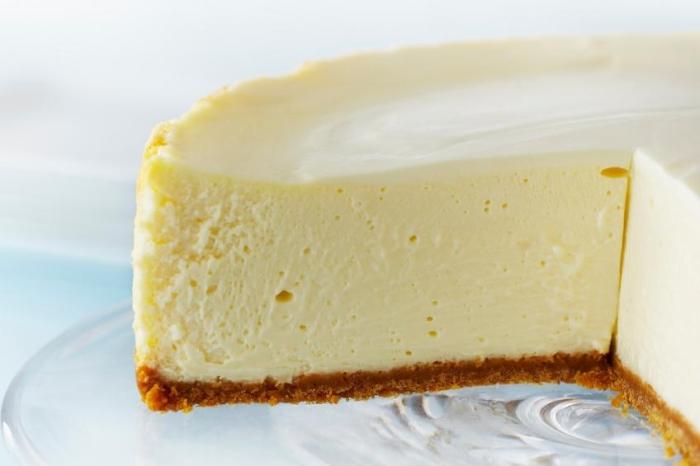
The final step in creating a perfect New York-style cheesecake is serving it. This is where you can unleash your creativity and present your masterpiece in a way that complements its rich flavor and elegant texture.
Presentation, Classic new york style cheesecake
A visually appealing presentation can elevate the enjoyment of your cheesecake. Here are some ideas:
- Slice and Serve:The classic way to serve cheesecake is to slice it into neat wedges using a sharp knife dipped in hot water. Place the slices on a serving platter, ensuring they are evenly spaced and arranged in a pleasing pattern.
- Garnish with Fresh Fruit:A vibrant assortment of fresh berries, sliced peaches, or kiwi adds a burst of color and sweetness to the cheesecake. Arrange the fruit artfully on top of the slices or create a beautiful fruit border around the platter.
- Drizzle with Sauce:A drizzle of chocolate ganache, caramel sauce, or a homemade fruit coulis adds a touch of indulgence and visual appeal. Use a piping bag or a spoon to create elegant swirls or designs on the cheesecake.
- Serve with Accompaniments:Pair your cheesecake with a variety of accompaniments like whipped cream, fresh mint leaves, or a sprinkle of toasted nuts.
Toppings and Accompaniments
| Classic Toppings | Innovative Toppings |
|---|---|
| Fresh Berries | Caramelized Apples |
| Whipped Cream | Chocolate Ganache |
| Chocolate Syrup | Fruit Coulis |
| Sprinkles | Candied Nuts |
| Cherries | Lemon Curd |
Ideal Serving Temperature
For the best flavor and texture, cheesecake should be served chilled. The ideal serving temperature is between 35-40°F (2-4°C). This ensures that the cheesecake is firm enough to slice cleanly but still has a creamy texture.

